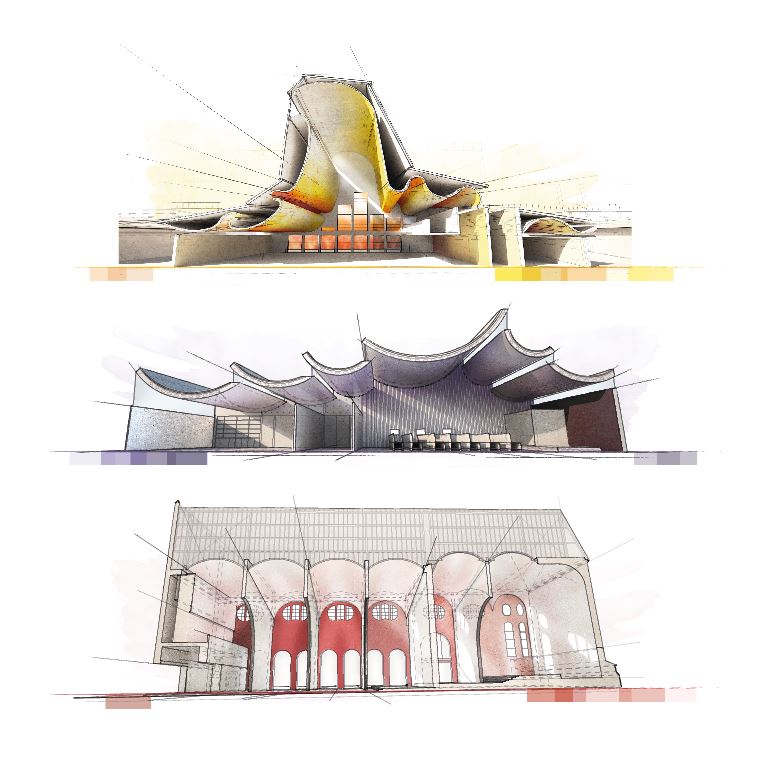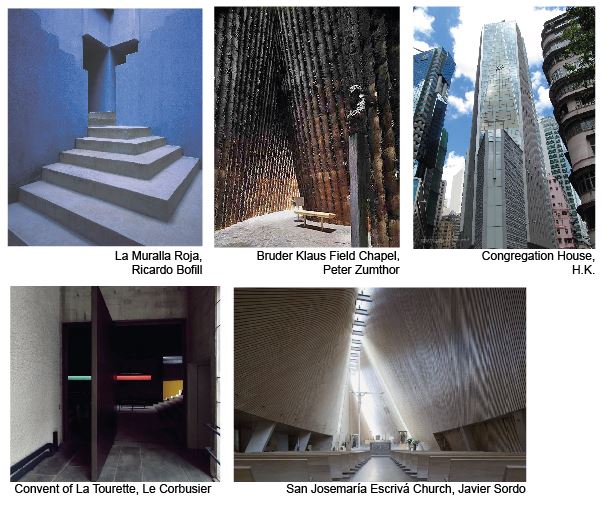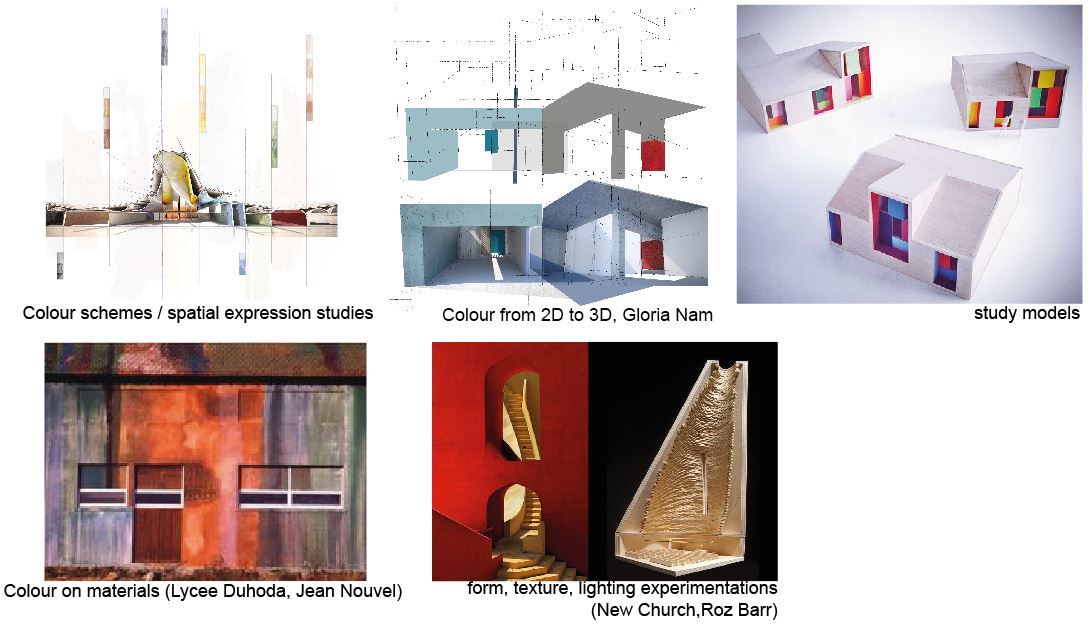|

This thesis explores how colours create an impact on space in relation to light intensity, texture and combination. It aims to include the method of colour progression as an intrinsic part of designing space in order to articulate architectonic features together with light and materials, highlighting the sensory experience and enhancing identity to the surroundings. Such method would be experimented through redesigning an urban church in Hong Kong.
WHY?

HISTORY
Colours in architecture has the ability to alter volume, to hold a surface or to recede space. Andrea Pozzo used the technique of quadrature which was emerging painting with St. Ignazio Church to create a three dimensional effect as if there is an extension of the church roof towards heaven.
Under the influence of De Stijl movement, Gerrit Rietveld used the contrast in primary colours from the paintings of Piet Mondrian on the design of Schroder House. He blurred the boundary of interior and exterior by letting the lines and intersecting planes extend outwards with the identical coloured surfaces. Similarly, in the Counter-construction project by Theo van Doesburg, he applied polychromy to the exterior walls to create spatial dissolution with coloured floating planes.
Through Maison Guiette, Le Corbusier criticized the approach of polychromy on exterior and believed that exterior should stay monochrome as it is considered as an envelope or a volume; whereas interior is polychrome. In his post-war buildings, Claude and Duval Factory and La Tourette, he treated colour as a final touch for spatial expression. He located bold colours in almost every interior element especially around apertures in relation to light. His works show the independency of colour and form. I would like to explore other ways of spatial expression such as the progression in colour intensity and how the gradient could highlight or recede space.
CURRENT
The idea of colour also expanded in works of Barragan who focused on the composition of colours by locating vibrant colours on planar surfaces, whereas Jean Nouvel revealed colours volumetrically through the properties of building materials. The Torre Agbar has a multi-colored facade that changes colours with the intensity of sunlight. Nouvel also created complex layers of colours and light with the reflectivity of materials from the Lycee Duhoda in Nimes.
THESIS PURPOSE
Rather than treating colour as an autonomous subject from form or space, this thesis will look at how the approach of colour progression creates depth in space or breaks the unity of volume with the support of light and shadow, textures and combination.
WHAT?

SCALE AND SCOPE
This thesis seeks to study the visual perceptions and emotions of colours in architecture. Hence, it would start with a series of fragments of spaces, from tall to narrow, to experiment colour with light intensity; colour as material; colour in combination. And these studies may bring forward to a larger scale of test case. To explore how varied tonalities affect spaces, I would like to apply my experimentation in an urban church in Hong Kong.
SITE AND REASON
The current proposed site is redesigning the Congregation House in Causeway Bay. As it is located in a dense area, so the lighting conditions will be more challenging and the traffic around will add another dimension to the context. Through this test case, I could investigate how the use and atmosphere of space can be transformed through different tonalities, creating different sensory perceptions.
Choosing to start off with smaller spaces is to focus on experimenting spatial qualities and certain architectural elements which may be useful in developing a larger site. This series of experimentations may explore how the perception changes with light or materials effects and ultimately lead to a broader scale of test cases that begin to challenge in the context of site and program.
HOW?

Colour alone gives flatness, what makes it have the ability to alter space is how light reacts, how materials give layers and how composition of colours changes focal point. To investigate how the progression in colours produce spatial expression on different aspects, experiments will be conducted in 3 categories: light intensity, materials and colour effects.
1- ANALYTICAL DESIGN RESEARCH
The thesis would begin with inserting colour schemes in church precedents as case studies to study strategic moments and spatial expressions. There will also be site analysis including light conditions, density and traffic.
2- METHODS
After testcase is confirmed, drawings of geometries and lines will be conducted to explore the potential architectural elements from 2D to 3D. Based on the drawings, the architectonics of spaces and volumes would be studied through modelling. Methods include trying different pigments and varnishes on materials which aim to create diverse effects in spatial qualities under different lighting conditions. (due Review 1.0)
3-PROTOTYPE ITERATIONS
To structure how the progression of colour is set on different scales or methods. (due Review 2.0)
4- REVISIONS/REFINEMENTS
Fine tuning colours on the ambience and impact on viewers through the spatial qualities, comparison on various colour progression within context will be studied. (due Review 3.0)
Bibliography:
Theory:
– Jan de Heer,1996, ‘The Architectonic Colour: Polychromy in the Purist Architecture of Le Corbusier’,
Academy Editions, London
– Gyorgy Kepes, 1944,’ Language of Vision’, Paul Theobald, Chicago
– William W. Braham,2002, ‘Modern Color/modern Architecture: Amédée Ozenfant and the Genealogy of Color in
Modern Architecture’, Ashgate, England
Techniques:
– Maggie Toy,1996, ‘Colour in Architecture’, Academy Editions, London
– Katrin Trautwein, 2010, ‘128 Colors’, Birkhauser, Basel
Current:
– Alejandro Bahamón,2010, ‘Light color sound : sensory effects in contemporary architecture ’, W.W. Norton & Co, New York
– Byron Mikellides, Tom Porter 2009, ‘Colour for Architecture Today’, Taylor & Francis, Oxon
– Tom Porter,1997,‘The Architect’s Eye: Visualization and Depiction of Space in Architecture’, E & FN Spon, London
|



